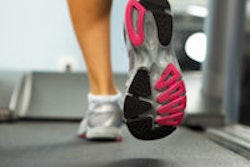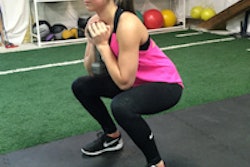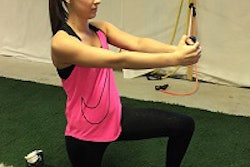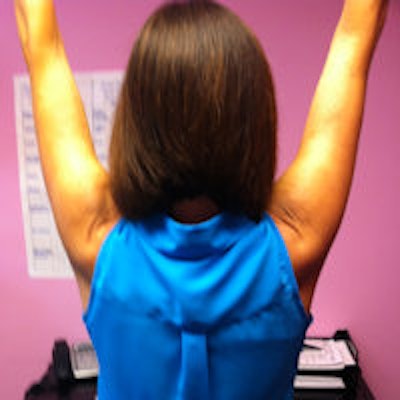
When speaking with sonographers and other groups of folks in the U.S. and around the world who work in pain, we find that nine out of 10 have neck and shoulder pain and/or are dealing with back issues that prevent them from doing their job at the optimal level.
In this new series of articles, we will look first at the "seven sins" that cause back issues and show you what to do to reduce -- and in the majority of cases eliminate -- back pain for good. We'll explore how to get rid of neck and shoulder pain in a subsequent series.
In our series on back pain, we'll address seven areas:
- Respiration and core
- Posture
- Limited thoracic mobility
- Limited hip mobility
- Weak/tight quadratus lumborum
- Weak glutes (aka butt amnesia)
- Poor lifestyle habits
By correcting these patterns of movement, improving mobility and strength in certain areas, and making a few minor changes in your life and training program, you can get rid of back pain and live free of pain. In this first article, we want to address the issue of how we breathe and how well we maintain our "core."
What is our core?
As strength and conditioning specialists, one of our pet peeves is the wording around the term "core." Most folks think the core is our abdominals, or the muscles in the stomach area. Many think that doing crunches will help strengthen the core.
However, this is incorrect, and what you'll find is that the traditional crunch is the worst exercise for most folks to do to strengthen their core.
The core is actually the musculature that includes all the muscles from our chest to our knees and all around the body; so even our lower back, hamstrings, hips, and upper back can be considered part of the core. Even some issues with neck pain can be related to our core being weak or not able to function properly (and we'll get into that in our upcoming series on the neck and shoulders).
When working with groups and setting up training programs, we find that in the majority of folks, breathing is the most common movement pattern that is done incorrectly.
Here is a test to see if you are a chest breather: Sit up tall in your chair and take five deep breaths. Do you feel and see your chest and shoulders going up and down? Are you doing a "minishrug" as you breathe? If you are, you are a chest breather and, in most situations, will also have some type of issue or pain associated with it. Experts find that 90% of movement dysfunction comes from improper breathing patterns.
We also find that chest breathers have upper-crossed syndrome. What is that, you ask? Our body works as a unit: in this case, as an "X" or cross pattern. If our abdominals (stomach area) are weak, we find that the gluteus maximus (butt) is also weak. If the hip flexors (front of the thighs) are tight, the erector spinae are tight (lower back). We see this "X" pattern throughout the whole body.
When these factors are in place, the outcome is back pain. To correct this problem, we need to strengthen certain areas and lengthen (stretch) other areas. It's been found that diaphragm breathers have a foundation of stability that helps with proper movement patterns. When we move properly, we can eliminate aches, pains, and problems such as those found in the back area. Without proper breathing, we will create a higher risk for stress in the back area.
Remember, our bodies always prioritize breathing over stability. Here are our top three exercises you can do to become a diaphragm breather.
Ankle grab deep-breathing exercise
This is a simple and easy exercise and stretch. Keep in mind: We want to learn to breathe through our diaphragm and not be a chest breather:
- Start by sitting on the edge of your chair. Try to find one that doesn't roll or have wheels.
- Simply bend over and grab your ankles, bringing your chest to your thighs and working to get your head down to your knees.
- Now take six to eight deep breaths, drawing in for four to five seconds and blowing out for four to five seconds. You should feel your stomach and intercostal muscles (along your love handles!) start to work. Because you are "pinning" your chest down, you have to take in air using the diaphragm in order to breathe. You might also notice a nice stretch in the lower back as you sit up.
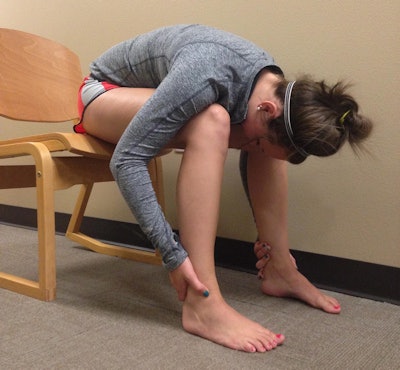 All images courtesy of Doug Wuebben.
All images courtesy of Doug Wuebben.This is an excellent exercise to do four to six times throughout the day when you feel your neck and shoulders getting tight or you have some stress. It only takes a few minutes, but it can make you feel great.
Overhead reach
We want to get ahead at work, so we spend more time at our desk, work to get in one more client, and push to do more and more. If we spend too much time working with the head forward, shoulders rolled, and hips tucked, we risk repetitive-use injuries that will start taking a greater toll on our bodies and our performance levels. We end up doing less, but taking more energy to do it. We work harder to become less effective and less efficient!
Taking a minute to perform the overhead-reach exercise a few times a day can offer huge positive results, and you never even have to leave your desk.
- Sitting at your desk or standing behind your chair, reach both arms overhead as high as possible, with palms facing in and thumbs pointing behind you.
- Here is the tricky part: As you extend your arms overhead, push your shoulders back -- think of pinching a pencil between your shoulder blades.
- Keep reaching as high as you can, and at the same time, exhale as if you were blowing out five huge candles.
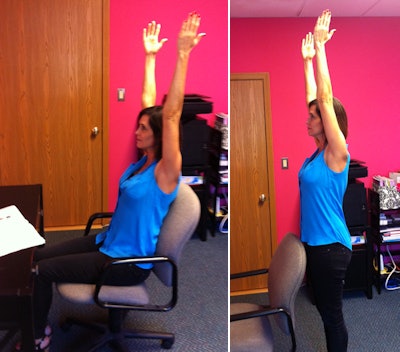
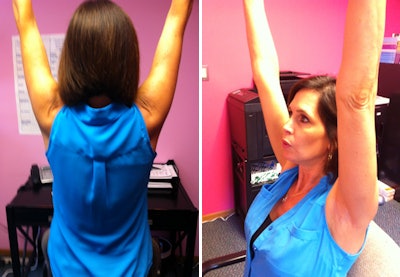
This should open up your chest, allowing you to breathe easier, while at the same time relieving stress and strain in your neck and shoulders.
Lateral resistance-band walk
First, choose a band that has the right resistance for you. The band colors indicate the level of resistance and progress from easy to hard. With most brands, the lighter the color (yellow), the less tension or easier it is. The darker colors (blue or black) have more tension and are harder to stretch.
We suggest that you begin with an easy band and progress to different color levels over time. The key to this exercise is to have the right band and perform the movement correctly:
- Place the band around both ankles. With your feet shoulder-width apart, the band should be taut, not stretched.
- Bend your knees slightly and move into an "athletic" or half-squat position. You should feel the glutes tighten. Keep your feet in line with your shoulders and face forward, with your body weight evenly distributed over both feet.
- Maintaining the half-squat position throughout the whole exercise, shift your weight to one leg and take a step laterally (sideways) with the other leg. Keep your hips level during the movement. Try not to "bounce" up and down as you move, and don't teeter-totter side to side.
- As you move, think "long step" for the lead leg and "short step" for the trail leg. Maintain tension on the band and never bring your feet all the way together.
- Travel eight to 10 steps, or about 10 to 15 yards. Then, facing the same direction, return back to the start with the other leg as the lead. You should feel your gluteus medius firing (your hips will burn) if you are doing it correctly.
In the second article of this seven-part series, we'll discuss how having good posture can help eliminate back pain and increase your energy.
Doug Wuebben is a registered echocardiographer and also a consultant, international presenter, and author of e-books in the areas of ergonomics, exercise and pain, and injury correction for sonographers. He has also been published on the topics of telemedicine and achieving lab accreditation.
Mark Roozen is a certified strength and conditioning specialist, a certified personal trainer, and a fellow of the National Strength and Conditioning Association (NSCA). He also consults, presents, writes, and works with groups, teams, and organizations around the world. He has been in the strength, conditioning, and performance field for over 30 years.
Wuebben and Roozen are co-founders of Live Pain Free -- The Right Moves. Email [email protected] or go to coachrozy.com for more information on programs, training, or speaking requests, or if you have any questions or comments.
The comments and observations expressed do not necessarily reflect the opinions of AuntMinnie.com.





